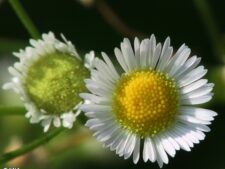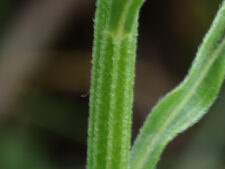
DAISY FLEABANE
Erigeron strigosus
SUNFLOWER FAMILY (Asteraceae)
 Identification
Identification
- Flowering time - May, June, July, August
- Common in disturbed areas
- Sunflower/aster/daisy-like with many outer white ray florets and yellow central disk
- Strap like upper leaves are not toothed or clasping - stem hairs, if any, are appressed (strigose)
- See comments section for comparison with our other 2 similar Fleabanes
This native annual grows from 1-3 feet tall. Hairs, if any, are appressed to the stem (strigose)(D). The fairly narrow, strap-like leaves do not clasp the stem (A,C). The white flower heads are less than 1 inch across with from 50-100 ray florets (petals) around a yellow central disk (B). For comparison with similar Erigeron species, Annual (E. annuus) and Philadelphia Fleabane (E. philadelphicus) see comments.
This plant is in flower from May to August in open, disturbed habitat including some of the prairie restorations.
This fleabane is best identified by the narrow, strap-like upper leaves which do not clasp the stem, and the lack of spreading hairs on the stems. Annual Fleabane (Erigeron annuus) has broader, toothed, upper non-clasping leaves and spreading stem hairs. Philadelphia Fleabane (Erigeron philadelphicus) is the only one with clasping leaves and, when present, the pinkish ray florets are helpful. Early flowering dates overlap, but any Erigeron flowering in July or August is not likely to be E. philadelphicus.
The common name fleabane is based on a belief that the dried flower heads when stuffed in bedding would get rid of fleas.
The content of NatureSearch is provided by dedicated volunteer Naturalists of Fontenelle Forest who strive to provide the most accurate information available. Contributors of the images retain their copyrights. The point of contact for this page is: Roland Barth.



